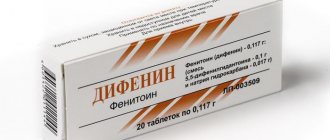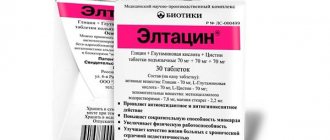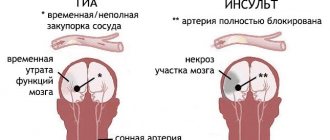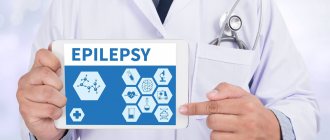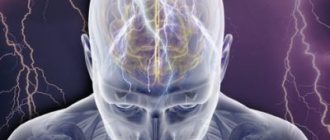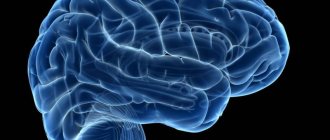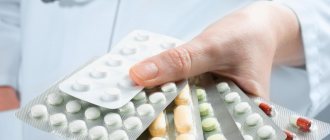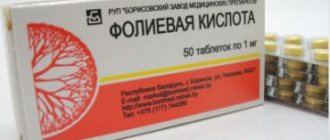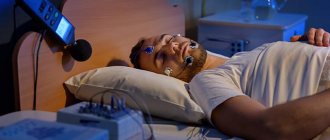Attracts some attention
possible involvement of glycine in epileptogenesis.
Like GABA, it inhibits neuronal activity at all levels of the central nervous system, but is greatest in the spinal cord and brain stem. It is possible that both amino acids inhibit paroxysmal excitation. In addition to its direct inhibitory effects, glycine may influence neuronal activity through its close association with glutamine metabolism as it inhibits glutamine synthetase. Perhaps the decrease in glutamine
during epileptic paroxysm is explained precisely by this circumstance.
In addition, glycine is a precursor to a number of important compounds
: tryptophan, histidine, carbamonyl phosphate, glucosamine-6-phosphate, AMP, i.e. can activate the “synthetic cycle”.
The glutamine system also affects acetylcholine
(OH). In particular, for its accumulation in an inactive form, ACh requires the presence of glutamic acid, potassium and magnesium nones. ACh is a mediator whose role in the pathogenesis of epilepsy has been discussed for quite some time. It is known to cause depolarization of pyramidal cells.
Cholinergic neurons are present in subcortical structures and the brain stem
, a significant proportion of cortical interneurons and reticulocortical neurons are cholinergic. The use of cholinesterase inhibitors, and especially poisoning with organophosphorus compounds, is often accompanied by the occurrence of convulsive epileptic seizures. A direct effect of cholinesterase inhibitors on epileptic activity has been shown. In patients with epilepsy, audiogenic stimulation, etc.), a significant increase in the level of serum cholinesterase was found.
Also in numerous experimental studies
In the brain tissue of animals after convulsions caused by various factors (amidopyrine injections, electric shock, auditive stimulation, etc.), a significant increase in cholinesterase activity was found. It is suggested that the main role in the mechanism of increased epileptic excitability is played by a violation of the relationship between catecholamines and acetylcholine. This is consistent with the data on the creation of the Cain model of experimental TLE, in which pathomorphological changes similar to those in human TLE occur in the hippocampus. Cannoic acid causes a significant increase in the content of ACh and a decrease in the content of norepinephrine. At the same time, the activity of glutamate carboxylase decreases and the reuptake of new acid by glutamates decreases, which is accompanied by an increase in the activity of the excitation neurotransmitter glutamate and a weakening of GABAergic transmission with the occurrence of epileptic seizures.
N. P. Bradford and PR Dodd (1976) consider the participation of AH to be undoubted
in the spread of epileptic seizures, although its role in their occurrence cannot yet be established.
Perhaps the greatest attention is drawn to the study of the state
in epilepsy, the system of biogenic amines, including catecholamines - dopamine, norepinephrine and adrenaline. This is understandable if we take into account the strategic role of these substances in basic neurophysiological processes. Many biogenic amines perform mainly a suppressive function, so a change in their content in brain tissue is accompanied by a facilitating effect.
Increased sensitivity to convulsive effects
determined in parallel with a decrease in the level of all biogenic amines in the brain. The period of maximum risk of seizures in mice and rabbits of genetically predisposed strains correlates with the period of decreased levels of serotonin and norepinephrine in the brain.
Glycine has been used for a long time as a medicine to influence higher mental functions. Glycine for epilepsy is allowed to be taken by both adults and children. The drug helps improve mental activity and calm the patient’s nervous system; it is often used to improve the patient’s condition in the complex treatment of seizures.
So is it possible to take Glycine for epilepsy?
Aminoacetic acid is found in all tissues of the human body. The largest amount of acid is found in the spinal cord and brain. It plays the role of a regulator of nerve cell activity, acting as an inhibitory transmitter.
In a special study, it was proven that Glycine can suppress epileptic seizures. More than half of the participants reported the absence of attacks or a decrease in their number after taking the medicine. Doctors advise children to use Glycine as an adjuvant in complex treatment.
The properties of aminoacetic acid help prevent catecholamines, which are produced by the human body in a stressful situation, from negatively affecting brain neurons. This effect helps to avoid an attack of epilepsy and possible sleep problems. Prescribing Glycine helps avoid taking powerful tranquilizers (Sibazon is often used).
People who suffer from epileptic seizures often experience problems with mental performance and other cognitive functions. The amino acid enhances the electrical activity of the occipital and frontal parts of the brain, which helps to concentrate the patient’s attention, improve his memory and normalize the speed of mental reactions.
A positive effect from a course of Glycine can be achieved in the presence of a post-traumatic form of epilepsy. The product provides the sore spot with normal blood flow and restores it after hypoxia.
After taking the drug, the impact of psycho-emotional factors on the patient’s nervous system is reduced:
- irritation is suppressed;
- excitability decreases;
- aggression and anger go away.
The drug does not have a cumulative effect, so it does not lead to addiction; after a course of treatment, withdrawal syndrome does not occur.
Finding safe and effective drugs
The effectiveness of Finlepsin retard is quite similar to Depakine hron - this means that the ability of the drug substance to provide the maximum possible effect is similar. For example, if the therapeutic effect of Finlepsin retard is more pronounced, then when using Depakine hron even in large doses it will not be possible to achieve this effect.
Also, the speed of therapy is an indicator of the speed of therapeutic action in Finlepsin retard and Depakin hron are approximately the same. And bioavailability, that is, the amount of a drug reaching its site of action in the body, is similar. The higher the bioavailability, the less it will be lost during absorption and use by the body.
Comparison of the safety of Finlepsin retard and Depakin hron
The safety of a drug includes many factors. At the same time, it is higher for Finlepsin retard than for Depakin hron. It is important where the drug is metabolized: drugs are excreted from the body either unchanged or in the form of products of their biochemical transformations.
Metabolism occurs spontaneously, but most often involves major organs such as the liver, kidneys, lungs, skin, brain and others.
When assessing the metabolism of Finlepsin retard, as well as Depakin hron, we look at which organ is the metabolizing organ and how critical the effect on it is.
The risk-benefit ratio is when the prescription of a drug is undesirable, but justified under certain conditions and circumstances, with the obligatory observance of caution in use. At the same time, Finlepsin retard has fewer risks when used than Depakin hron.
Also, when calculating safety, it is taken into account whether only allergic reactions occur or possible dysfunction of the main organs. In other matters, as well as the reversibility of the consequences from the use of Finlepsin retard and Depakin hron.
Comparison of contraindications of Finlepsin retard and Depakin hron
Based on the instructions. The number of contraindications for Depakine Chron is large, but it is greater than for Finlepsin Retard. This is a list of symptoms with syndromes, and diseases, various external and internal conditions under which the use of Depakine Chron or Finlepsin Retard may be undesirable or unacceptable.
Comparison of addiction between Finlepsin retard and Depakin hron
Like safety, addiction also involves many factors that must be considered when evaluating a drug.
So, the totality of the values of such parameters as “o syndrome” in Finlepsin retard is quite similar to the similar values in Depakin hron. Withdrawal syndrome is a pathological condition that occurs after the cessation of intake of addictive or dependent substances into the body.
And resistance is understood as initial immunity to a drug; in this it differs from addiction, when immunity to a drug develops over a certain period of time. The presence of resistance can only be stated if an attempt has been made to increase the dose of the drug to the maximum possible.
At the same time, in Finlepsin retard the meaning of the “syndrome” is quite small, however, the same as in Depakin hron.
Comparison of side effects of Finlepsin retard and Depakin hron
Side effects or adverse events are any adverse medical event that occurs in a subject after administration of a drug.
Depakine Chron has more adverse effects than Finlepsin Retard. This implies that the frequency of their occurrence is low in Depakine Chron and low in Finlepsin Retard.
Frequency of manifestation is an indicator of how many cases of an undesirable effect from treatment are possible and registered.
The undesirable effect on the body, the strength of influence and the toxic effect of drugs are different: how quickly the body recovers after taking it and whether it recovers at all. When using Depakine Chron, the body's ability to recover faster is higher than that of Finlepsin Retard.
Comparison of ease of use of Finlepsin retard and Depakin hron
This includes dose selection taking into account various conditions and frequency of doses. At the same time, it is important not to forget about the release form of the drug; it is also important to take it into account when making an assessment.
The ease of use of Depakine Chron is better than that of Finlepsin Retard.
The drugs are compiled by experienced pharmacists who study international research. The report is generated automatically.
Last update date: 2019-09-19 06:01:43
Source: https://meds.is/whats-better/29-depakin-khrono-or-39-finlepsin-retard
The effect of glycine on the patient's body
Glycine is especially widely used in epileptology, especially in the treatment of neuroses that arise due to epilepsy.
The medicinal effect of taking the drug is characterized by the following features:
- has an anti-stress effect;
- nootropic effect: memory and attentiveness improves;
- can cleanse the body of toxins and harmful substances (during alcohol intoxication and other forms of toxic poisoning);
- helps improve immune defense;
- suppresses aggressiveness, conflict and other uncontrollable manifestations of nervousness;
- eliminates hematopoietic disorders;
- stimulates normal blood circulation in the brain.
The drug has its advantages, which any patient should know about. These include:
- minimal number of contraindications and side effects;
- allowed for use by patients of any age;
- Glycine does not cancel the course of taking another drug;
- There is no pronounced addiction or withdrawal syndrome.
Glycine: contraindications, side effects in adults, elderly, if Forte, instructions, indications
Contraindications to taking Glycine are intolerance to the components (rare) and low blood pressure.
Adverse reactions: allergies (sore mouth, rashes, itchy skin), drowsiness, dizziness, darkening of the eyes. Used with caution by transport drivers due to deterioration of attention and reduced reaction speed.
When combined with sleeping pills, sedatives, and blood pressure-lowering drugs, an undesirable increase in their effect may occur.
Glycine Forte "Evalar" is a dietary supplement containing glycine and vitamins B1, B6, B12, it is contraindicated in children, is not used in cases of intolerance to the components, and is used with caution in cases of thrombosis, ulcers, and gastritis. Glycine Forte can also be registered as a medicine that differs from the usual one in a higher dose, then it is prohibited only for hypotension and allergies.
Glycine: contraindications
Glycine is contraindicated in case of intolerance to the active substance - aminoacetic acid or the auxiliary components of the tablet:
- povidone,
- magnesium stearate,
- methylcellulose,
- aspartame,
- sorbitol
The most common side effects and contraindications for adults are associated with arterial hypotension. When blood pressure is below 100/60 mmHg. Art. the drug is not used. It can further reduce arterial tone and impair blood flow to the brain.
During pregnancy
During pregnancy, Glycine is not used for course treatment, since there is no evidence of its safety for the fetus.
Not enough studies have been conducted to confirm the possibility of prescribing the drug to breastfeeding women.
In emergency cases (for example, the threat of cerebrovascular accident), the medication may be recommended, but only under the condition of constant medical supervision and once.
For the elderly
Elderly people tolerate Glycine well; there are no additional contraindications. It is well absorbed, and the water and carbon dioxide formed as a result of processing are easily eliminated, so no age-related dosage adjustments are required.
We recommend reading about the benefits and harms of Glycine. From the article you will learn about why you should drink Glycine, the pros and cons of using it, whether you can drink Glycine every day, and recommendations for taking it.
And here is more information about the compatibility of Glycine and alcohol.
Glycine: contraindications and side effects
Glycine is contraindicated in patients at risk of side effects such as allergic reactions and low blood pressure. This may manifest itself in:
- burning in the mouth;
- soreness;
- increased salivation during resorption;
- skin rashes;
- skin itching;
- deterioration of breathing;
- dry hacking cough.
Drug intolerance is rare. The second group of side effects is associated with a decrease in blood pressure, which causes:
- headache, dizziness;
- darkening of the eyes, flickering dots;
- nausea;
- general weakness;
- decreased ability to concentrate.
Patients with a tendency to hypotension need to monitor their readings more often with a tonometer; if they decrease, stop taking Glycine and consult a doctor to reduce the dose or replace the drug.
Precautionary measures
Caution should be exercised when using the medication when driving vehicles or operating dangerous machinery at work. This is explained by Glycine’s ability to cause drowsiness, reduce reaction speed and concentration.
Patients simultaneously taking sleeping pills, sedatives and for high blood pressure should take into account that Glycine enhances their effect. This may require a revision of dosages.
Glycine Forte: contraindications
Glycine Forte is produced by several manufacturers; tablets have different compositions and contraindications. For example, a drug produced by Canonpharma Production differs from the usual one only in its increased dosage (250 mg). Therefore, it is also prohibited for intolerance and low blood pressure, pregnancy and breastfeeding.
Glycine Forte "Evalar" has a wider range of contraindications: it is not prescribed to patients if there have been allergic reactions to vitamin B1, B6 or B12 in the past. This dietary supplement is used only for adult patients. It is imperative to consult a doctor before using the tablets if:
- menopause and premenopausal period;
- peptic ulcer of the stomach and duodenum;
- gastritis with increased acidity of gastric juice;
- pancreatitis during exacerbation;
- severe liver and kidney diseases;
- coronary heart disease (angina pectoris, recent heart attack);
- increasing the level of red blood cells in the blood;
- benign and malignant tumors;
- increased blood clotting, thrombosis.
Brief instructions for Glycine
Glycine tablets are used for resorption; they are placed under the tongue or behind the cheek; if swallowing is difficult, they can be crushed to a powder and mixed with a small amount of water. The most common treatment regimens are listed in the table.
| Certain attention attracts possible involvement of glycine in epileptogenesis. Like GABA, it inhibits neuronal activity at all levels of the central nervous system, but is greatest in the spinal cord and brain stem. It is possible that both amino acids inhibit paroxysmal excitation. In addition to its direct inhibitory effects, glycine may influence neuronal activity through its close association with glutamine metabolism as it inhibits glutamine synthetase. Possibly decreased glutamine during epileptic paroxysm is explained precisely by this circumstance. In addition, glycine is a precursor to a number of important compounds : tryptophan, histidine, carbamonyl phosphate, glucosamine-6-phosphate, AMP, i.e. can activate the “synthetic cycle”. The glutamine system also affects acetylcholine (OH). In particular, for its accumulation in an inactive form, ACh requires the presence of glutamic acid, potassium and magnesium nones. ACh is a mediator whose role in the pathogenesis of epilepsy has been discussed for quite some time. It is known to cause depolarization of pyramidal cells. Cholinergic neurons are present in subcortical structures and the brain stem , a significant proportion of cortical interneurons and reticulocortical neurons are cholinergic. The use of cholinesterase inhibitors, and especially poisoning with organophosphorus compounds, is often accompanied by the occurrence of convulsive epileptic seizures. A direct effect of cholinesterase inhibitors on epileptic activity has been shown.
Also in numerous experimental studies In the brain tissue of animals after convulsions caused by various factors (amidopyrine injections, electric shock, auditive stimulation, etc.), a significant increase in cholinesterase activity was found. It is suggested that the main role in the mechanism of increased epileptic excitability is played by a violation of the relationship between catecholamines and acetylcholine. This is consistent with the data on the creation of the Cain model of experimental TLE, in which pathomorphological changes similar to those in human TLE occur in the hippocampus. Cannoic acid causes a significant increase in the content of ACh and a decrease in the content of norepinephrine.
N. P. Bradford and PR Dodd (1976) consider the participation of AH to be undoubted in the spread of epileptic seizures, although its role in their occurrence cannot yet be established. Perhaps the greatest attention is drawn to the study of the state in epilepsy, the system of biogenic amines, including catecholamines - dopamine, norepinephrine and adrenaline. This is understandable if we take into account the strategic role of these substances in basic neurophysiological processes.
Increased sensitivity to convulsive effects determined in parallel with a decrease in the level of all biogenic amines in the brain. The period of maximum risk of seizures in mice and rabbits of genetically predisposed strains correlates with the period of decreased levels of serotonin and norepinephrine in the brain. – We also recommend “ Biogenic amines in epilepsy. Norepinephrine and adrenaline in epilepsy” Table of contents of the topic “Epilepsy and the mechanisms of its development”: 1. Epilepsy in brain tumors. The meaning of slow brain activity 2. Epileptic brain. Epileptization of the brain 3. Neuroglia in epilepsy. Disorganizing influences of the epileptic focus 4. Neurochemistry of epilepsy. Glutamine system in epilepsy 5. Cerebrospinal fluid in epilepsy. Glutamine system and taurine in epilepsy 6. Glycine and acetylcholine in epilepsy. Acetylcholine metabolism in epilepsy 7. Biogenic amines in epilepsy. Norepinephrine and adrenaline in epilepsy 8. Catecholamine metabolism in epilepsy. Hypoadrenal type of response in epilepsy 9. Chronic stress in epilepsy. Serotonergic system in epilepsy 10. Cyclic nucleotides in epilepsy. The role of calcium in the development of epilepsy | ||
| Diagnosis or purpose of use | Dosage per day | Course of application |
| Increased mental performance | 1 tablet 2-3 times | 2-3 weeks |
| Mental retardation in a child | 1 tablet 2 times | 1 month |
| Stressful state | 1 tablet 2-3 times | 2-4 weeks |
| Increased excitability in a child | 1 tablet 2 times | 1-2 weeks |
| Mood swings in an adult | 1 tablet 3 times | 2 weeks |
| Sleep disorders | 1 tablet 20 minutes before bedtime | 1-2 months |
| Ischemic stroke or threat of its development (ischemic attack) | 10 tablets per cheek or under the tongue (can be rubbed) immediately when symptoms appear and for another 5 days, then 1 month, 1 tablet 3 times | |
| Alcoholism | 1 tablet 2-3 times | Monthly 4-6 times a year |
Indications for use of Glycine in adults
Glycine is indicated for use in adult patients with:
- reduced mental performance;
- sleep disturbances (difficulty falling asleep, frequent awakenings);
- stress;
- emotional stress (for example, an exam session, conflicts at work or family);
- neurotic disorders;
- cardiopsychoneurosis;
- previous traumatic brain injury;
- consequences of brain tissue infection (meningitis, encephalitis);
- encephalopathy (deterioration of brain function) due to circulatory disorders or alcoholism;
- menopausal syndrome with increased excitability, memory impairment, insomnia;
- ischemic stroke and transient (temporary) cerebrovascular accidents;
- treatment of chronic alcoholism (usually in combination with coding or other techniques).
Useful properties of Glycine Forte from Evalar
Glycine Forte produced by "Evalar" has a therapeutic and prophylactic effect due to the combination of glycine and B vitamins (B1, B6, B12), its main beneficial properties:
- reduction of increased excitability, irritability;
- improving mental performance, memorizing and processing new information;
- normalization of the central nervous system, helping it to withstand stress;
- restoring the duration and depth of sleep, making it easier to fall asleep.
It is important to take into account that Glycine Forte “Evalar” is a dietary supplement, so it should be used primarily for prophylactic purposes, and in case of illness, use the medication Glycine in combination with vitamins (for example, Neurobion).
We recommend reading about the benefits of Glycine Forte. From the article you will learn about the characteristics of the drug, instructions for use, side effects, differences from regular Glycine.
And here is more information about how much Glycine you can take per day.
Glycine is contraindicated in case of intolerance to the components or low blood pressure. Due to unproven safety, it is not used during pregnancy or breastfeeding. Drivers and when taking sleeping pills and sedatives at the same time should take into account the risk of drowsiness.
Watch this video about when Glycine is prescribed:
Source: //glicin.online/gliczin-protivopokazaniya/
Drug interactions
Glycine can react with a large number of chemical compounds (nitrites, ketones, sulfur). The product has an antitoxic effect and helps reduce the negative effects of harmful substances. For this reason, the drug is often prescribed in the presence of intoxication.
The drug helps reduce the toxic effects of certain psychotropic medications that are often prescribed to patients with epilepsy. It maintains amino acid levels in cells. Glycine reduces the side effects of taking antidepressants, tranquilizers, anticonvulsants and sleeping pills.
Contraindications and side effects
The main advantage of the product is that it has no absolute contraindications, and is also suitable for patients of any age group. A ban on its use may be individual intolerance to the active components in the medicine and low blood pressure.
When taking the drug for a course, no side effects occur. Allergies manifest themselves extremely rarely and most often in the form of a rash on the surface of the skin. In hypotensive patients, the drug often leads to a drop in blood pressure.
Dosage for children and adults
It must be remembered that Glycine is a non-essential amino acid. The medicine is distinguished by its inhibitory effect, which helps reduce the amount of glutamine in the body during epilepsy.
When treating a child, as in the case of other patients, the most important thing is to choose the correct dosage.
The instructions for the drug advise using the standard course of administration - 30 days. Children over 14 years of age take 3 tablets every day, they are simultaneously placed under the tongue and dissolved.
Children who have recently been born are allowed to give half a tablet several times a day, mixed with milk, the average time of administration is about 14 days. For children from one year to 14 years old, the doctor prescribes 1.5-2 tablets several times a day, the course lasts 14 days. The dosage in all cases is prescribed exclusively by a pediatrician.
Adults and children need to be treated with Glycine comprehensively. The number of tablets per day will be prescribed by the doctor; it will directly depend on the form of the disease, the number of daytime epileptic seizures, the degree of damage to the nervous system, the general effect of epilepsy on the body and the presence of accompanying symptoms.
The standard dosage of the active substance for an adult is 200 mg. The tablets are placed under the tongue and dissolved, the use continues for the next 30 days. It is allowed to take the drug in powder form. To do this, you need to take 2-3 tablets and crush them thoroughly. For a lasting effect, the resulting medicine must be inhaled several times a day. Glycine can be safely added to medications for the treatment of epilepsy attacks. Reviews about the treatment with the product are always positive.
The drug Glycine has a nootropic effect and is prescribed for a large number of vascular pathologies.
It simultaneously reduces nervous excitability and stimulates mental activity.
It is widely used in the complex treatment of convulsive seizures, having a positive effect on the condition of patients. Glycine is also used in the treatment of epilepsy.
Depakin (Chrono, Chronosphere, Enterik): analogues, instructions for use, price, composition and reviews
One of the complex pathologies of the functionality of the nervous system is epilepsy. Medicines are selected taking into account the etiology of the disease and the presence of associated problems.
The drug Depakine effectively reduces excitability, improves the patient's mental state, and improves mood.
Thanks to the properties of the active substance and a properly selected regimen, it is possible to achieve a successful treatment result.
Compound
The antiepileptic drug is based on valproic acid.
For better absorption of the substance by the body in the production of tablet form, the following are used:
- sodium saccharin;
- hypromellose;
- talc;
- macrogoal
Other chemical compounds are also used as auxiliary components, depending on the form produced:
- solution for external use (drops);
- granules;
- lyophilisate (for intravenous administration);
- syrup.
Pharmacology
The main component of the drug has a sedative and central muscle relaxant effect.
The principle of operation is to increase the content of GABA (gamma-aminobutyric acid) in the central nervous system.
This process is made possible by inhibiting GABA transferase and reducing the reuptake of gamma-aminobutyric acid in the brain.
Systemic use of Depakine reduces excitability and inhibits seizures that develop in epilepsy in the motor areas of the brain.
The active substance has antiarrhythmic activity. In the totality of the zones of influence, the drug can achieve a high therapeutic effect.
Price
You can buy antiepileptic medicine in pharmacies and online stores.
The product is sold subject to the provision of a prescription written in Latin.
Average cost by regions of the Russian Federation:
- Depakine Enteric (300 mg) – 675 rubles . for 100 tablets;
- Depakine Chrono (500 mg) – 245 rubles . for 30 tablets;
- granules Depakine Chronosphere (100 mg) – 596 rub . for 30 pcs.
Recommendations for adult patients
The antiepileptic drug is used to eliminate the manifestations of the following pathologies:
Use in pediatrics
Depakine is used in pediatrics to eliminate manifestations of epilepsy of various origins.
In addition to reducing the activity of seizures, the medicine helps to correct the patient’s character and behavior, which have deviations characteristic of the disease.
The active substance provides high therapeutic results for the following problems:
- febrile convulsions, childhood tics;
- seizures occurring due to organic brain diseases;
- manic-depressive psychosis of the bipolar type;
- Lennox-Gastaut, West syndromes, etc.
Restrictions on use
The manufacturer in the annotation indicates the following list of diseases for which Depakine is not prescribed:
- allergy to the components of the composition;
- hepatitis (in acute and chronic forms of development);
- pancreatic dysfunction;
- liver failure, porphyria;
- pathology of the hemostatic system;
- a decrease in platelet count below the standard value (with severe symptoms);
- pregnancy (first trimester);
- lactation period.
A number of diseases have been identified for which valpoic acid-based products are used with caution.
Among the large list of pathologies: low protein content in the blood, congenital enzymopathies, liver dysfunction, inhibition of bone marrow hematopoiesis.
Adult patients
The antiepileptic drug should be taken orally, combined with food.
The tablet should be swallowed whole with a glass of purified water. The syrup is mixed with a small amount of water or added directly to food.
The treatment regimen recommended by the manufacturer involves two or three times .
The daily dosage is calculated taking into account the patient’s body weight - for each kg of weight there are 15 mg of the drug at the initial stage of therapy (for body weight over 25 kg).
Subsequently, the dosage is increased every 1-2 weeks by 5-10 mg. The resulting figure is daily, so it is divided into 2-3 doses in equal portions. The maximum allowable amount of the drug is 30 mg/kg (in rare cases - up to 60 mg).
It is prohibited to increase a single dose on your own due to the high risk of side effects.
Before adjusting the treatment regimen and dosage, the specialist monitors the concentration of the active substance of the drug in the blood plasma.
Children
Patients whose weight does not exceed 25 kg are provided with the following daily allowance:
- for newborns – up to 30 mg/kg;
- at the age of 3 to 10 years – up to 40 mg/kg.
When using only Depakine, the dosage is set from 15 to 45 mg/kg, in combination with other pharmacological products - 30-100 mg/kg.
Recommendations for intravenous use of the drug
The daily norm is 25 mg/kg. The injection is given at intervals of 1; 1.5; 2 days.
The diluted powder is administered intravenously using the jet method (400-800 mg). The use of a dropper is also allowed.
When switching from oral to injection use, it is important to maintain a 4-6 hour interval between the last pill and the first injection.
The initial injection dose should be 0.5-1 mg per kg of patient weight.
Overdose
With an increase in the recommended dose, manifestations characteristic of intoxication are possible.
The risk of side effects also increases.
If you feel unwell or have other signs of poisoning, you should stop taking the medicine and seek medical help.
Side effects
During testing of the antiepileptic drug, cases of side effects .
Among the common ones:
- psychosis, irritability, encephalopathy, stupor, enuresis and other central nervous system disorders;
- flickering of spots in the eyes, involuntary oscillatory movements of the eyes, disorders of the visual system;
- gastralgia, hepatitis, pancreatitis and other problems with the digestive system;
- thrombocytopenia, leukopenia, anemia and other disorders in the hematopoietic organs;
- unreasonable gain of muscle mass or its decrease;
- allergic manifestations;
- dysfunction of the endocrine system;
- alopecia, hemodialysis.
To eliminate anxiety symptoms, it is recommended to take the following measures:
- rinse the stomach;
- take sorbent;
- cause forced diuresis.
If relief is not observed, you need to call an ambulance.
Interaction
Valproic acid during complex treatment may lose its properties or cause side effects if the medications were selected incorrectly.
Depakine in combination with certain drugs reduces the therapeutic effect and neutralizes the effect of the active components of other drugs.
The annotation contains an impressive list of medications with which valproic acid is not recommended to be combined.
Reviews
Tatyana, 26 years old:
Miron, 33 years old:
Precautionary measures
Some problems may arise when using Depakine.
To avoid them, it is recommended to adhere to the following precautions:
- It is important to undergo tests periodically to monitor the activity of liver transaminases, platelets in the blood, bilirubin levels, etc. Studies are carried out every 2-3 months, especially when combining the drug with other pharmacological agents of similar action.
- The daily dosage changes throughout the therapy: at the initial stage, a minimum amount of the drug is supposed to be taken, then the dosage is increased weekly to the maximum determined by the attending physician. A couple of weeks before stopping the medication, the daily dose is reduced to the initial level.
- You cannot combine Depakine with drinking alcohol.
- If surgery is planned during the period of antiepileptic therapy or after its completion, the patient undergoes tests to monitor important indicators.
- If signs of an “acute abdomen” appear, you need to donate blood for testing. This will exclude or confirm the diagnosis of acute pancreatitis (monitoring amylase levels).
- If the patient has diabetes, the results of blood and urine tests may be distorted due to the concentration of keto products.
- You should not abruptly stop taking Depakine due to the high risk of increased frequency of epileptic seizures.
- Taking antiepileptic medications provokes a decrease in concentration and causes inhibition of psychomotor reactions. During the period of use of the medicine, driving motor vehicles and performing high-risk work should be avoided.
- To prevent the manifestation of dyspeptic disorders, it is recommended to include enveloping agents and antispasmodics in therapy.
Analogs
If necessary, the antiepileptic drug Depakine can be replaced with an analogue that has similar pharmacological properties.
Effective options include:
- Encorat – 160 rubles;
- Encorat Chrono – 165 rubles;
- Convulex - 98 rubles;
- Valparin, Valparin XP – 179 rubles.
A substitute should be selected exclusively by a qualified specialist who has a complete picture of the patient’s disease.
Source: https://psihbolezni.ru/lechenie/depakin-hrono-hronosfera-enterik-analogi-instruktsiya-po-primeneniyu-tsena-sostav-i-otzyvy/
Effect on the patient's body
The amino acid has extensive experience of use in epileptology, especially in people suffering from neuroses due to epilepsy.
The therapeutic effect of the drug is due to the following aspects:
- Providing a universal anti-stress effect.
- Nootropic effect, expressed by improving memory and attention.
- The ability to relieve intoxication (in the case of alcoholic, toxic forms of the disease).
- Immunostimulating effect.
- Prevention of attacks of aggression, uncontrollable mental reactions.
- Normalization of cerebral circulation.
Advantages of the product:
- Minimum contraindications and side effects.
- No age restrictions.
- Possibility of combination with other medications.
- No addiction, no withdrawal syndrome.
Use of amino acid composites in the treatment of epilepsy
INTRODUCTION
It has been established that currently the basis of epileptic seizures is the trigger mechanism of the carrier, which is a group of neurons with pathophysiological properties that represent the epileptic focus.
An “explosion” of epileptic activity from the focus with the subsequent development of clinical manifestations of the disease indicates the insufficiency of protective mechanisms. The epileptic focus acquires structural features.
Significant energetic disturbances are observed around the focus, leading to increased membrane permeability and electrolyte concentrations.
Disturbances in the metabolism of amino acids, in particular, glutamic acid (capturing mediator) and g-aminobutyric acid (GABA) (inhibitory mediator) are one of the most important links in these disorders.
Their content, as well as the content of aspartic acid, glycine, taurine and others, ranges from 30-40% of the normal level.
The concentration of amino acids that are not directly involved in modulating neuronal activity remains constant.
The purpose of our study was to determine the effectiveness of amino acid compounds in the treatment of epilepsy patients with various forms of attacks.
MATERIALS AND METHODS OF RESEARCH
After analyzing the treatment of 55 patients with epilepsy. There were 26 men and 29 women. Their ages ranged from 2 to 50 years, mostly from 11 to 30 years. The duration of the disease ranged from several months to 10 years or more. 28 patients suffered from generalized seizures, 6 of them had no seizures and 21 had mixed seizures.
In some patients, seizures have been recorded in the context of organic cerebral pathology, mental retardation, mental retardation, etc.
In 7 patients, partial seizures were observed. Their frequency was different.
All patients received drugs that increased the level of GABA, while simultaneously reducing the amount of glutamic acid (AMINOVIL, Trevit, Avit, PRIMAVIT) in individual doses depending on age and frequency of attacks.
In principle, control was carried out both with dynamic observation of patients and electroencephalography. In 55 patients, EEGs were done with functional loads; in 24 of them, EEGs were done twice: at the beginning and at the end of treatment. In 32 patients, the EEG showed an epileptic focus of various localization and in 18 diffuse changes were recorded.
In addition, computer examination of the brain was performed in 10 patients, nuclear magnetic tomography was performed in 7, Echo-EG in 35 and fundus examination in 28 subjects.
The course of treatment lasts 4-6 weeks. 45 patients completed course 1, 9 patients completed course 2, and 1 patient completed course 3 of treatment. At the same time, all patients received basic traditional anticonvulsant therapy.
RESEARCH RESULTS
Treatment taking into account follow-up produced the following effect: in 25 patients the frequency of attacks decreased and in 5 patients they stopped completely. During treatment, 24 patients did not experience any seizures at all, while in only 1 patient their occurrence became more frequent.
The EEG data were the most convincing: in 16 patients (out of 24), positive dynamics were recorded on the EEG, which was expressed in reduced epileptic activity, normalization of cortical rhythms, etc.
Complete disappearance of epileptic foci was observed in 4 patients. At the same time, in 7 patients the EEG did not change and in only 1 negative dynamics were found, which coincided with more frequent attacks.
Of great interest was the change in the general condition of the patients. 20 patients reported, in the context of treatment, that anxiety levels had decreased; nocturnal attacks ceased in 5 subjects.
14 patients became calmer, children became more diligent, played actively with toys and showed greater interest in the environment; 2 children ran away from home less often. In 4, sleep returned to normal. By the end of treatment, a 14-year-old child learned how to light matches, became interested in cars and began reading books about cars.
In 1 patient, the skin became clear and the attacks stopped while the general condition improved. And only 15 patients who underwent treatment showed no visible changes in behavior.
CONCLUSION
Thus, the use of amino acid compounds in the complex therapy of epilepsy produces a significant beneficial effect and can be recommended with simultaneous correction of anticonvulsants.
Article added May 24, 2020
Source: //volynka.ru/Articles/Text/1280
Drug interactions
Glycine has the ability to interact with many chemical compounds (nitrates, sulfur preparations, ketones).
It has an antitoxic effect and reduces the negative impact on the body. This explains the prescription of the drug for the toxic form of the disease.
The antitoxic effect also extends to psychotropic medications, often prescribed to epileptics. It prevents these drugs from reducing the level of amino acids in cells.
Thus, Glycine reduces the side effects of anticonvulsants, antidepressants, and sleeping pills.
Indications
The medicine is widely used in patients with epilepsy.
Indications for use are:
- seizures;
- post-traumatic, toxic form of the disease;
- cognitive disorders accompanying the disease;
- the occurrence of neurosis-like conditions, attacks of aggression, anxiety;
- vegetative-vascular dystonia;
- sleep disturbance, difficulty falling asleep.
